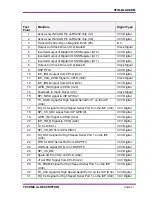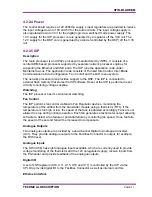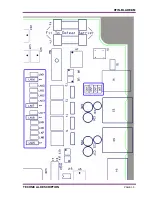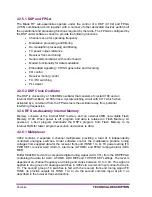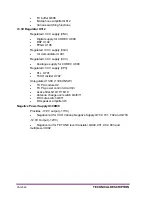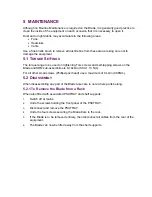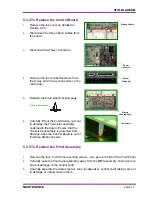
XFIN-BLADE-SM
TECHNICAL DESCRIPTION
PAGE
41
4.3.3.2 Tx Power Control
Output power is stabilised by a power control feedback loop. L1, R54, a printed circuit
transmission line, D6 and associated components comprise the power detector with
Q3/10, U3 and associated components providing the power setting and control sections.
Forward and reverse power is sampled by the power detector and applied as a DC voltage
to the inverting input of comparator U3A. The TX PWR SET voltage, which is a DC voltage
proportional to the programmed TX power setting, is applied to the non-inverting input of
the comparator. PA module output level changes due to supply voltage, load or
temperature variations are detected and applied to the comparator which proportionally
adjusts the PA driver (Q12) supply, and therefore the PA drive level, via Q10/Q3. High
temperature protection is provided by Thermistor R452 which progressively reduces the
power level if the PA module temperature becomes excessive, approximately 86C case
temperature. Q15 and Q16 provide for dual power control time constants necessary for
good power ramp and decay characteristics.
4.3.3.3 Antenna Changeover and Harmonic Filter
The antenna changeover circuit consisting of pin diodes D3/D4/D5 is switched by
Q4/Q8/Q11 and associated circuitry allowing the transmitter output to be coupled to the
antenna while providing isolation for the receiver input. With the transmitter switched on,
the diodes are forward biased allowing power to be coupled through to the antenna and
isolating the receiver by grounding its input at C28. The short circuit at the receiver input is
transformed to an effective open circuit at D3 by L13, which minimises transmitter loading.
With the transmitter switched off the diodes are reverse biased allowing the receiver input
signal to reach the receiver front-end with minimal loading and loss. The harmonic
rejection low pass filter comprises L10/11/12 and associated capacitors.
4.3.3.4 Transmitter Audio Processing
Microphone audio input signals of 40mV RMS, with a source impedance of 470 ohms, are
provided at the microphone input (AUD IN1) by the Control Board. Pre-emphasised flat-
audio, (300Hz – 3kHz; 20Hz – 3kHz; or 20Hz – 5.8kHz) is provided to the transmitter by
the Control Board via the 26-way ribbon cable. U108 is a control gate for the microphone
audio signals.
AUD IN2 is the external audio options and data input used by the Blade Control Board.
This is controlled by gate U107. Inverter Q20 ensures that the mic. audio is muted when
the data or audio options signals are active. The AUD IN2 input level and source
impedance is the same as the microphone input. Alternatively, the Blade can bypass the
audio input circuits by sending a digital audio stream to the transceiver module.
Q812 is a unity gain amplifier that provides buffering of the audio and data signals. U103B
provides CODEC input switching which selects either the receiver I signal or transmitter
audio/data signals depending on the TX/RX mode. All pre-emphasis, filtering,
compression and limiting processes for narrow and wideband operation are carried out in
the CODEC (U800) under the control of the DSP. The processed transmitter audio/data
from the CODEC output at VOUTL is applied to the VCO as a modulation signal with a
level of approximately 200mV P/P.
Summary of Contents for Xfin Blade
Page 10: ......
Page 22: ......
Page 35: ...XFIN BLADE SM TECHNICAL DESCRIPTION PAGE 35...
Page 50: ......
Page 58: ...PAGE 58 PRODUCT VARIANTS AND ACCESSORIES...
Page 64: ...PAGE 64 SPARES...
Page 72: ...PAGE 72 PROGRAMMER GUIDE...
Page 75: ...XFIN BLADE SM CONTROL CARD BLOCK DIAGRAM PAGE 75 B CONTROL CARD BLOCK DIAGRAM...
Page 76: ......

